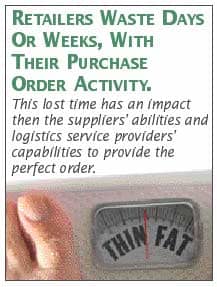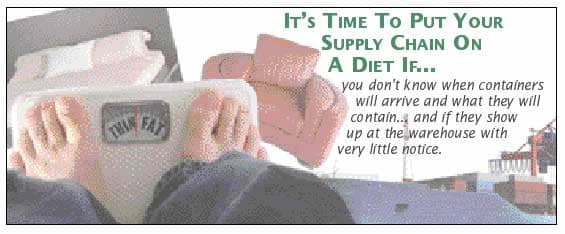Lean supply chain management is a challenge for manufacturers, wholesalers, distributors and retailers. Being lean means removing waste from operations. Lost time is the biggest result of waste. For furniture retailers, time really is money in the form of increased costs including those associated with carrying inventory.

Managing purchase orders, suppliers and logistics service providers who are thousands of miles away in different time zones has become a major challenge. Retailers may rightfully be wary of tackling supply chain issues. There are language barriers; long lead and transit times; customs clearance difficulties, port delays, homeland security, and logistics infrastructure problems. Many different manufacturing, transportation, financial service, and logistics companies can be involved in any furniture that is sourced overseas. This complexity has made supply chain management more difficult and much more important.
Lean is not just issuing purchase orders to offshore suppliers and telling them quantities, styles, colors and ship dates. Nor is it just specifying the freight forwarder or steamship line you want them to use. That approach simply specifies a series of actions to be taken, but offers little management oversight or control. Instead it is simply a handoff of tasks to different supply chain participants with no performance metrics. It creates a supply chain that is in expedite mode or does not know what is coming into them and when. That is not lean logistics, and that is not supply chain management.
Lean Benefits
The benefits of being lean for importers are significant. When retailers manage the flow of products and information, the following positive results occur:
- Compressed cycle times.
- Reduced logistics costs.
- Decreased inventory levels.
- Supply chain visibility.
- Improved supplier and logistics performance.
Time compression creates opportunities to reduce inventory levels and logistics costs. However, firms that do offshore sourcing are, by definition, adding time and, in turn, costs and inventory. Import cycle time also affects the utility, value and placement of inventory. These affect customer service, sales revenues, inventory-to-cash cycle time and profits.
Lower Logistics costs come from the predictability of an operation that does not have waste. Predictability means greater usage of planned modes and planned shipping schedules. It means less need for expediting shipments at higher cost.
Inventory Improvements come from less need for safety stock and faster movement through the supply chain to the store or to the customer’s door. In a lean operation, having the right inventory, at the right place and at the right time are the norm.

Supply Chain Visibility occurs when importers manage purchase orders, supplier performance and logistics service. This cannot be accomplished with emails and faxes. Online technology is needed to provide the necessary integration. The technology needs to have exception and event management capabilities so that scheduled events occur, and remedial actions take place quickly. All this removes blind spots in the supply chain that create waste.
Lean Determination. If you want to become lean, you need to assess your present operation. How effective are your present practices? A good first step includes defining what you expect from your import supply chain and then measuring how well your present system functions.
Next analyze your offshore supply chain process. This means making sure that your operation uses both an internal and external process. Firms often confuse the day-to-day transactions they make, with an actual process. The import supply chain is horizontal and crosses many internal departments and many external sourcing and logistics firms. Companies that fail to understand the process, struggle to achieve lean logistics. Instead of being lean, they force their inefficient practices on their external suppliers and logistics firms. This can compound their inability to be lean.
Non Lean Operations
Common indicators of a non-lean operation include:
Poor information flow. Company does not know when a container will arrive and what it will contain. Containers show up at the warehouse with very little notice.
Poor product flow. Lead times have too much variability. The result is ebbs of inventory bunching and gaps without any inventory. Inventory availability has little relationship to seasonal upswings in demand or sales driven by planned promotions.
Two performance metrics should be used to assess the operation. One is the incidence of obtaining perfect orders; namely a purchase order that is received complete, accurate and on time.
The other is the total purchase order to delivery cycle time. There are three parts to the offshore supply chain:
- Internal purchase order preparation.
- Supplier performance.
- Logistics performance.
Many firms waste days, even weeks, with their purchase order activity. This lost time has an impact on suppliers’ abilities and logistics service providers’ capabilities to provide the perfect order.
Wasted time can also occur in the purchase order-delivery cycle when orders are placed with U.S. firms who use offshore suppliers, contract manufacturing and factories. Each additional company involved in supplying information and or products can add inefficiency to the cycle time. Importers must work with suppliers to make sure that the lean initiative does not falter.
Lean Techniques
There are many techniques that furniture retailers can use to work toward achieving a lean supply chain:
- Use technology to manage supplier performance and to integrate the movement of information among and between all parties.
- Design a process that is lean and includes all parties.
- Collaborate with key suppliers and logistics providers.
- Link demand and demand planning with replenishment and buying.
- Reduce the number of suppliers and logistics service providers to streamline the supply chain, without sacrificing results.
- Focus on supplier performance; control the supply chain at the international source. The offshore supply chain begins with the purchase order. Transportation is a derivative of the purchase order and of supplier performance.
- Understand transport differences and your options. For example: ocean carriers offering different transit times, different sailing schedules, different destination ports and different canals to the East Coast (Panama Canal versus Suez Canal).
- Align your financial supply chain with your trade supply chain. These two chains involve different sets of players with differing objectives and practices
- Use a 4PL or 3PL to manage your offshore supply chain. Work with a supply chain service provider that understands the total supply chain complexity and operation. His interest should be your supply chain, including your suppliers and purchase orders, not just your freight. The firm should use process, technology and people to do this. The people should be located in the same country and locality as your suppliers.
CONCLUSION
To thrive in today’s import heavy business environment, furniture retailers must be committed to lean supply chain practices. Assuming that your suppliers will deliver as promised, leaving your supply chain unexamined and unmanaged will, over time, put you at a competitive disadvantage. Being lean may require logistics engineering and business process design for importers or an outside supply chain firm may need to be brought in. However you decide to approach this issue, remember that lean is not a one-time change; it requires ongoing improvements and attention. Only then will you be able to excise the waste from your supply chain and to make it efficient.
Tom Craig has 25+ years experience in logistics, both international and domestic. His company Ltd. Shippers Association leverages the buying power of its members for lower ocean freight rates. Ltd. also provides logistics/supply chain management consulting. He is the author of numerous articles on supply chain management. Questions can be directed to Tom at tomcraig@furninfo.com.